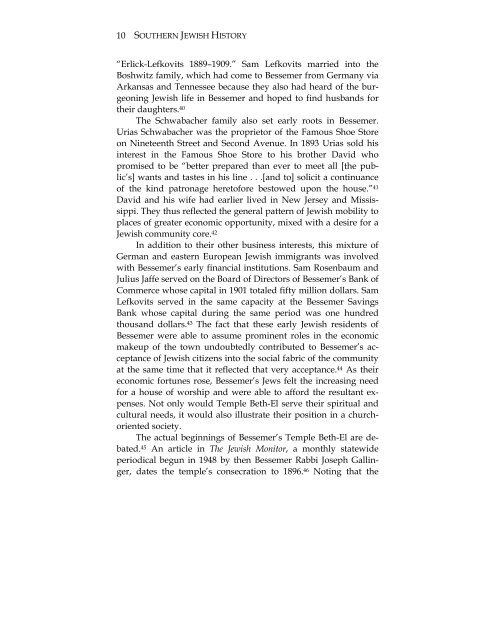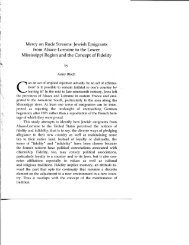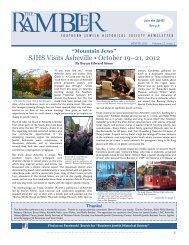A Shtetl Grew in Bessemer - Southern Jewish Historical Society
A Shtetl Grew in Bessemer - Southern Jewish Historical Society
A Shtetl Grew in Bessemer - Southern Jewish Historical Society
You also want an ePaper? Increase the reach of your titles
YUMPU automatically turns print PDFs into web optimized ePapers that Google loves.
10 SOUTHERN JEWISH HISTORY<br />
“Erlick-Lefkovits 1889–1909.” Sam Lefkovits married <strong>in</strong>to the<br />
Boshwitz family, which had come to <strong>Bessemer</strong> from Germany via<br />
Arkansas and Tennessee because they also had heard of the burgeon<strong>in</strong>g<br />
<strong>Jewish</strong> life <strong>in</strong> <strong>Bessemer</strong> and hoped to f<strong>in</strong>d husbands for<br />
their daughters. 40<br />
The Schwabacher family also set early roots <strong>in</strong> <strong>Bessemer</strong>.<br />
Urias Schwabacher was the proprietor of the Famous Shoe Store<br />
on N<strong>in</strong>eteenth Street and Second Avenue. In 1893 Urias sold his<br />
<strong>in</strong>terest <strong>in</strong> the Famous Shoe Store to his brother David who<br />
promised to be “better prepared than ever to meet all [the public’s]<br />
wants and tastes <strong>in</strong> his l<strong>in</strong>e . . .[and to] solicit a cont<strong>in</strong>uance<br />
of the k<strong>in</strong>d patronage heretofore bestowed upon the house.” 41<br />
David and his wife had earlier lived <strong>in</strong> New Jersey and Mississippi.<br />
They thus reflected the general pattern of <strong>Jewish</strong> mobility to<br />
places of greater economic opportunity, mixed with a desire for a<br />
<strong>Jewish</strong> community core. 42<br />
In addition to their other bus<strong>in</strong>ess <strong>in</strong>terests, this mixture of<br />
German and eastern European <strong>Jewish</strong> immigrants was <strong>in</strong>volved<br />
with <strong>Bessemer</strong>’s early f<strong>in</strong>ancial <strong>in</strong>stitutions. Sam Rosenbaum and<br />
Julius Jaffe served on the Board of Directors of <strong>Bessemer</strong>’s Bank of<br />
Commerce whose capital <strong>in</strong> 1901 totaled fifty million dollars. Sam<br />
Lefkovits served <strong>in</strong> the same capacity at the <strong>Bessemer</strong> Sav<strong>in</strong>gs<br />
Bank whose capital dur<strong>in</strong>g the same period was one hundred<br />
thousand dollars. 43 The fact that these early <strong>Jewish</strong> residents of<br />
<strong>Bessemer</strong> were able to assume prom<strong>in</strong>ent roles <strong>in</strong> the economic<br />
makeup of the town undoubtedly contributed to <strong>Bessemer</strong>’s acceptance<br />
of <strong>Jewish</strong> citizens <strong>in</strong>to the social fabric of the community<br />
at the same time that it reflected that very acceptance. 44 As their<br />
economic fortunes rose, <strong>Bessemer</strong>’s Jews felt the <strong>in</strong>creas<strong>in</strong>g need<br />
for a house of worship and were able to afford the resultant expenses.<br />
Not only would Temple Beth-El serve their spiritual and<br />
cultural needs, it would also illustrate their position <strong>in</strong> a churchoriented<br />
society.<br />
The actual beg<strong>in</strong>n<strong>in</strong>gs of <strong>Bessemer</strong>’s Temple Beth-El are debated.<br />
45 An article <strong>in</strong> The <strong>Jewish</strong> Monitor, a monthly statewide<br />
periodical begun <strong>in</strong> 1948 by then <strong>Bessemer</strong> Rabbi Joseph Gall<strong>in</strong>ger,<br />
dates the temple’s consecration to 1896. 46 Not<strong>in</strong>g that the







